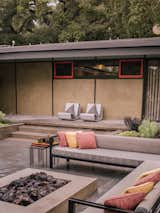[ad_1]
“We like to provide different ways of experiencing the environment,” says architect Alice Fung of her firm Fung + Blatt’s outside-in approach to design. Such was the case for her and partner Michael Blatt’s slow-but-steady development of a hillside property in San Marino, where a constellation of pavilions now dot the landscape.
In San Marino, Fung + Blatt Architects updated a property with a midcentury home originally designed by Calvin Straub. Besides renovating the main house, pictured here, the firm added a series of pavilions to the landscape. Elysian Landscapes joined at a later time and contributed to several patios, green roofs, and much of the garden.
While the property was sold to Mary Blodgett and Carlton Calvin as a teardown, the couple saw its potential. “It was falling apart, but gorgeous,” recalls Mary. “I’m a preservationist when I can be.” In the living room of the main house, a sofa by Patricia Urquiola surrounds a Nathan Young coffee table, capped with a floor lamp by Achille Castiglioni.
On a promontory at the center sits the original 1954 house, designed by Calvin Straub in a Japanese-influenced midcentury style. Over a period of five years, the architects remade the main house and added a ceramics studio, library, guesthouse, and pool house to align with the owners’ artistic inclinations and love of entertaining.
Inspired by the rigorous geometry and post-and-beam construction of the original home, but wanting to evolve it to something more playful and open, the architects designed the pavilions one at a time to be in dialogue with the site.
From the glass-backed shelving forming the walls of the ceramics studio to the massive sliding doors that transform the pool house into an open-air pavilion hovering over the water, the architects embraced the California midcentury spirit of indoor/outdoor living. “We’re always trying to relate to the site so the architecture isn’t just an object propped there,” says Fung. Blatt agrees: “The buildings are made to become the landscape.”
Interior Designer: Fung + Blatt Architects
General Contractor: Westmont Construction
Structural Engineer: Fung + Blatt Architects (main house remodel, library, guest house, ceramics studio); Polon + Lewis (pool house)
[ad_2]








